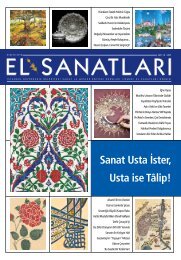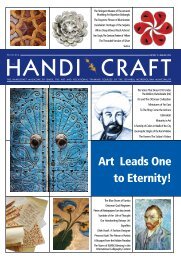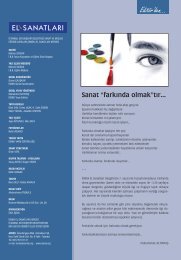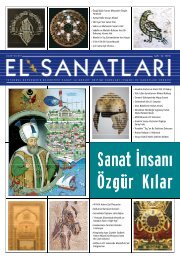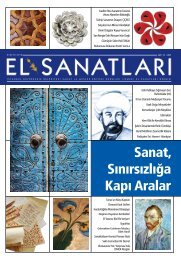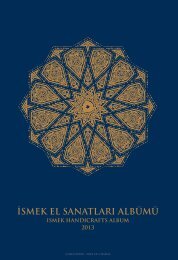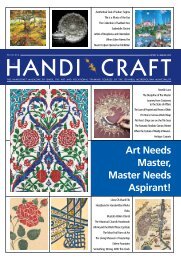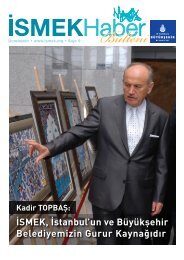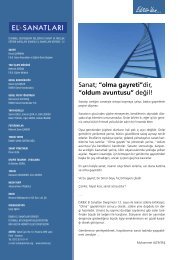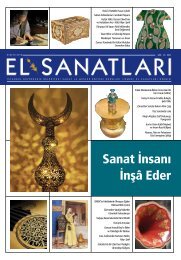Download Link - Ä°SMEK
Download Link - Ä°SMEK
Download Link - Ä°SMEK
Create successful ePaper yourself
Turn your PDF publications into a flip-book with our unique Google optimized e-Paper software.
surround the daily life and which host their turbanned<br />
or fezzed visitors, are in front of our eyes all the time.<br />
Shaded by cypress trees most of the time, graveyards are<br />
like mirrors which show us the existance of the angel of<br />
death, which will visit all of us some day. The french author<br />
T. Gautier writes “I don’t know why, but when I’m<br />
at a Turkish graveyard, I don’t feel the sorrow that I feel<br />
at a Christian graveyard.” The German Marshal H. Von<br />
Moltke says: “Graves crown the forelands around Istanbul,<br />
which have the most beautiful landscapes possible.<br />
If it’s true that spirits which leave the body sometimes<br />
wonder around graves, these spirits are watching in the<br />
full moon light the hills in both Europe and Asia, the<br />
bright mirrorlike reflection of the Bosphorus and Marmara,<br />
and this hugely populated city half million residents<br />
of which will be sleeping under these cypress trees<br />
almost in 100 years.”<br />
1) For more information on Mimar Sinan’s Works in Uskudar, see Mehmet Mermi<br />
Haskan, Yuzyıllar Boyunca Uskudar, (Uskudar throughout centuries) Vol. 1, Istanbul<br />
2001, pp. 261-262. 2) The cherity Stones, the best samples of whom we can see<br />
on Doğancılar Avenue in Uskudar, and beside the Mirahur (Imrahor) mosque built in<br />
1597, are rare and precious historical pieces we inherit from our dearest ancestors.<br />
The cherity Stone which is located in front of the iron woven window of the burial<br />
place on Gundoğumu Avenue, to the left of the place where prayer times were calculated<br />
and announced,, however, is shorter and of a more different style than most<br />
other cherity Stones which are similar to it. Being used today as a stool so that the visitors<br />
who climb up hill can have a rest, This cherity Stone once used to be the sign<br />
of the helping hands reached out to the poor. 3) Mehmed Raif, Mir’at-ı Istanbul, (the<br />
Miracle of Istanbul) Âlem Printinghouse, Istanbul 1314, p. 107. See also. Ayvansarâyî<br />
Huseyin Efendi, Hakîkatu’l-Cevâmi’ (Edited by Ahmed Nezih Galitekin), Işaret Press,<br />
Istanbul 2001, p. 617. 4) Dr. Gulçin Erol Canca, Uskudar Ahmediye Kulliyesi ve Lale<br />
Devri Mimarisi Içinde Bir Değerlendirme, Uluslararası Uskudar Sempozyumu VI, (a review<br />
based on the Ahmediye College in Uskudar and the Tulip Era Architecture, the<br />
6th International Symposium) Istanbul 2008, pp. 193-195. 5) For more information<br />
on the Works by Ismail Hakkı Bursevi, who was born in Istanbul, (died in 1725) and<br />
Also, Poet Yahya Kemal, who best grasped the glory of<br />
the Islamic Turkish civilisation which came into existance<br />
with the Ottoman Empire, describing it in his verses in<br />
the most effective way, teaches us a meaningful lesson<br />
with the statement “A nation who comprehends its nationality<br />
is the one who lives with its dead.” 15 Which he<br />
gave in one of his talks. Spread in 2 divisions on both<br />
southern and western sides of the mosque, the burial<br />
place of the Ahmediye College conjoins at the point<br />
where Gundoğumu Avenue and Esvapçı Street conjoin.<br />
The division on Gundoğumu Avenue is surrounded by<br />
a 6-arched window wall. The other division begins at<br />
the corner of the street, and ends above the entrence<br />
gate. The division on the Avenue side has gravestones<br />
of Fiduciary Ahmet ağa who died in 1730, his 2 sons,<br />
his daughters and his wife, as well as the examples of<br />
other gravestones which gives us information about ornamental<br />
decorations used on gravestones during the<br />
Tulip Era. The ornaments on the gravestones reflect the<br />
Tulip Era motives which are on the other side of the college.<br />
The fruit motives on the plates which are situated<br />
on the pehle parts of the gravestones in front of the<br />
arched window which sees the main avenue are quite<br />
magnificent. Also, some lodge symbols on some of the<br />
gravestones are noteworthy. The cypress tree reliefs that<br />
we see on the pulpet of the mosque can also be seen on<br />
the gravestones which are on the side of the yard. In the<br />
burial place where we see the examples of the talik and<br />
sulus, which are 2 of the beautiful handwriting styles,<br />
the rose motives on the written gravestones are glorious.<br />
Also, in the burial place where the open domed<br />
tomb of Kefçe Dede is located adjacent to the mosque,<br />
the uninscripted sarcophagus of Emin Mehmed Efendi,<br />
a Divan poet and the Uskudar Molla, is breathtaking.<br />
The sarcophagus was once used as a visiting point. The<br />
burial place also hosts the imams and madrasah teachers<br />
who served in the mosque. The beautifully inscripted,<br />
turbaned grave Stone of the great Molla Mustafa<br />
Asım Efendi, which was ornated with paradice tree reliefs,<br />
is worth seeing. The sarcophaguslike gravestone of<br />
the builder of the college, Fiduciary Ahmed Ağa, whose<br />
epigraph which was dated 1730 was written on, is in<br />
the shape of a cornered column without holes. The<br />
flower motived and inscripted headed gravestones of<br />
Ahmed Ağa’s sons, Osman ağa, and Emin Muhammed<br />
Ağa, both have the same date (November 1746), are the<br />
beautiful examples of the classical Tulip Era style flower<br />
motives which are coming out of delicate vases. The<br />
rose reliefs with their leaves and branches which were<br />
carved on the inscripted heads of both sarcophaguses,<br />
the 1733 dated sarcophagus ornated with cypress tree<br />
reliefs, and the turbaned sarcophagus of the great molla<br />
Mehmed Emin Efendi which is ornated with paradice<br />
tree reliefs, are unique examples for Uskudar.<br />
As a result, built in 1721-1722 (1134 according to the<br />
Muslim Calendar) by Mehmed Ağa, the chief architect of<br />
the Tulip Era, at the order of Ahmed Ağa, who was the<br />
Navy Yard Fiduciary, The Ahmediye College is considered<br />
to be an important complex which represents the period<br />
between 1703 and 1730, that is called the Tulip Era in<br />
the Ottoman Architecture and the culture history, as well<br />
as the transition to the westernisation period after the<br />
classical period. Though the college reflects the characteristics<br />
of the Tulip Era architecture, the patterns of flower<br />
bouquets in vases which ornate the tombstones inside<br />
the fenced burial place (burial place) in the pulpit of the<br />
mosque, are extremely remarkable with their naturalist<br />
style, just as the patterns which can be seen on the Fountain<br />
of Ahmed the 3rd in Uskudar, (1727-28) which was<br />
built at the same time with the Fountain of Ahmet the<br />
3rd (1728) in front of the Topkapı Palace. Being a comprehensive<br />
and middle scale college, the Ahmediye College<br />
consists of a mosque, a madrasah, (Religious school) a<br />
classroom, a library, a water serving building and a fountain.<br />
By the way it was built and by its characteristics, the<br />
college is considered to adhere to the general characteristics<br />
of the classical Ottoman architecture.<br />
for the dates he lived in Uskudar, where he first came in 1722, see. Ayvansarâyî Huseyin<br />
Efendi, a.g.e. , pp. 617-619. 6) For further information, see. Mehmet Nermi Haskan,<br />
Yuzyıllar Boyunca Uskudar, (Uskudar throughout centuries) Vol. I, Istanbul 2001,<br />
pp. 63-67. Also, for the architect of the college, see. Mehmet Nermi Haskan, a.g.e. ,<br />
Vol. I, p. 389. 7) For more information on the period during which the madrasah was<br />
used as a lodge, (Sheikh Mahmut Efendi Lodge) see. Mehmet Nermi Haskan, Yuzyıllar<br />
Boyunca Uskudar, (Uskudar throughout centuries) Vol. I, Istanbul 2001, p. 406. 8)<br />
Dr. Gulçin Erol Canca, a.g.m. , p. 195. 9) Mehmed Raif, a.g.e., p. 108. 10) For further<br />
information, see. Mehmet Nermi Haskan, Yuzyıllar Boyunca Uskudar, (Uskudar<br />
Throughout Centuries) Vol. II, Istanbul 2001, pp. 898-899. 11) Dr. Gulçin Erol Canca,<br />
a.g.m. , p. 196. 12) For further information, see. Mehmet Nermi Haskan, Yuzyıllar<br />
Boyunca Uskudar, (Uskudar Throughout Centuries) Vol. III, Istanbul 2001, p. 1037.<br />
13) For further information, see. Mehmet Nermi Haskan, Yuzyıllar Boyunca Uskudar,<br />
(Uskudar Throughout Centuries) Vol. III, Istanbul 2001, pp. 1207-1209. 14) For further<br />
information, see. Mehmet Nermi Haskan, Yuzyıllar Boyunca Uskudar, (Uskudar<br />
Throughout Centuries) Vol. II, Istanbul 2001, p. 945; Dr. Gulçin Erol Canca, a.g.m.<br />
pp. 195-196. 15) Ord. Prof. Dr. A. Suheyl Unver, Yahya Kemal’in Dunyası, (Yahya<br />
Kemal’s World) Tercuman Tarih ve Kultur Press, Istanbul 1980, p. 150.<br />
160



